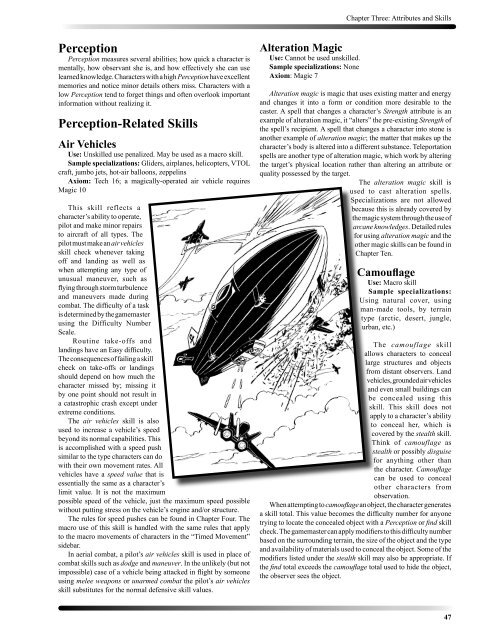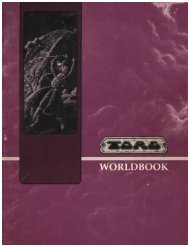Torg Player Rules
Torg Player Rules
Torg Player Rules
Create successful ePaper yourself
Turn your PDF publications into a flip-book with our unique Google optimized e-Paper software.
Perception<br />
Perception measures several abilities; how quick a character is<br />
mentally, how observant she is, and how effectively she can use<br />
learned knowledge. Characters with a high Perception have excellent<br />
memories and notice minor details others miss. Characters with a<br />
low Perception tend to forget things and often overlook important<br />
information without realizing it.<br />
Perception-Related Skills<br />
Air Vehicles<br />
Use: Unskilled use penalized. May be used as a macro skill.<br />
Sample specializations: Gliders, airplanes, helicopters, VTOL<br />
craft, jumbo jets, hot-air balloons, zeppelins<br />
Axiom: Tech 16; a magically-operated air vehicle requires<br />
Magic 10<br />
This skill reflects a<br />
character’s ability to operate,<br />
pilot and make minor repairs<br />
to aircraft of all types. The<br />
pilot must make an air vehicles<br />
skill check whenever taking<br />
off and landing as well as<br />
when attempting any type of<br />
unusual maneuver, such as<br />
flying through storm turbulence<br />
and maneuvers made during<br />
combat. The difficulty of a task<br />
is determined by the gamemaster<br />
using the Difficulty Number<br />
Scale.<br />
Routine take-offs and<br />
landings have an Easy difficulty.<br />
The consequences of failing a skill<br />
check on take-offs or landings<br />
should depend on how much the<br />
character missed by; missing it<br />
by one point should not result in<br />
a catastrophic crash except under<br />
extreme conditions.<br />
The air vehicles skill is also<br />
used to increase a vehicle’s speed<br />
beyond its normal capabilities. This<br />
is accomplished with a speed push<br />
similar to the type characters can do<br />
with their own movement rates. All<br />
vehicles have a speed value that is<br />
essentially the same as a character’s<br />
limit value. It is not the maximum<br />
possible speed of the vehicle, just the maximum speed possible<br />
without putting stress on the vehicle’s engine and/or structure.<br />
The rules for speed pushes can be found in Chapter Four. The<br />
macro use of this skill is handled with the same rules that apply<br />
to the macro movements of characters in the “Timed Movement”<br />
sidebar.<br />
In aerial combat, a pilot’s air vehicles skill is used in place of<br />
combat skills such as dodge and maneuver. In the unlikely (but not<br />
impossible) case of a vehicle being attacked in flight by someone<br />
using melee weapons or unarmed combat the pilot’s air vehicles<br />
skill substitutes for the normal defensive skill values.<br />
Alteration Magic<br />
Use: Cannot be used unskilled.<br />
Sample specializations: None<br />
Axiom: Magic 7<br />
Chapter Three: Attributes and Skills<br />
Alteration magic is magic that uses existing matter and energy<br />
and changes it into a form or condition more desirable to the<br />
caster. A spell that changes a character’s Strength attribute is an<br />
example of alteration magic, it “alters” the pre-existing Strength of<br />
the spell’s recipient. A spell that changes a character into stone is<br />
another example of alteration magic; the matter that makes up the<br />
character’s body is altered into a different substance. Teleportation<br />
spells are another type of alteration magic, which work by altering<br />
the target’s physical location rather than altering an attribute or<br />
quality possessed by the target.<br />
The alteration magic skill is<br />
used to cast alteration spells.<br />
Specializations are not allowed<br />
because this is already covered by<br />
the magic system through the use of<br />
arcane knowledges. Detailed rules<br />
for using alteration magic and the<br />
other magic skills can be found in<br />
Chapter Ten.<br />
Camouflage<br />
Use: Macro skill<br />
Sample specializations:<br />
Using natural cover, using<br />
man-made tools, by terrain<br />
type (arctic, desert, jungle,<br />
urban, etc.)<br />
The camouflage skill<br />
allows characters to conceal<br />
large structures and objects<br />
from distant observers. Land<br />
vehicles, grounded air vehicles<br />
and even small buildings can<br />
be concealed using this<br />
skill. This skill does not<br />
apply to a character’s ability<br />
to conceal her, which is<br />
covered by the stealth skill.<br />
Think of camouflage as<br />
stealth or possibly disguise<br />
for anything other than<br />
the character. Camouflage<br />
can be used to conceal<br />
other characters from<br />
observation.<br />
When attempting to camouflage an object, the character generates<br />
a skill total. This value becomes the difficulty number for anyone<br />
trying to locate the concealed object with a Perception or find skill<br />
check. The gamemaster can apply modifiers to this difficulty number<br />
based on the surrounding terrain, the size of the object and the type<br />
and availability of materials used to conceal the object. Some of the<br />
modifiers listed under the stealth skill may also be appropriate. If<br />
the find total exceeds the camouflage total used to hide the object,<br />
the observer sees the object.<br />
47



